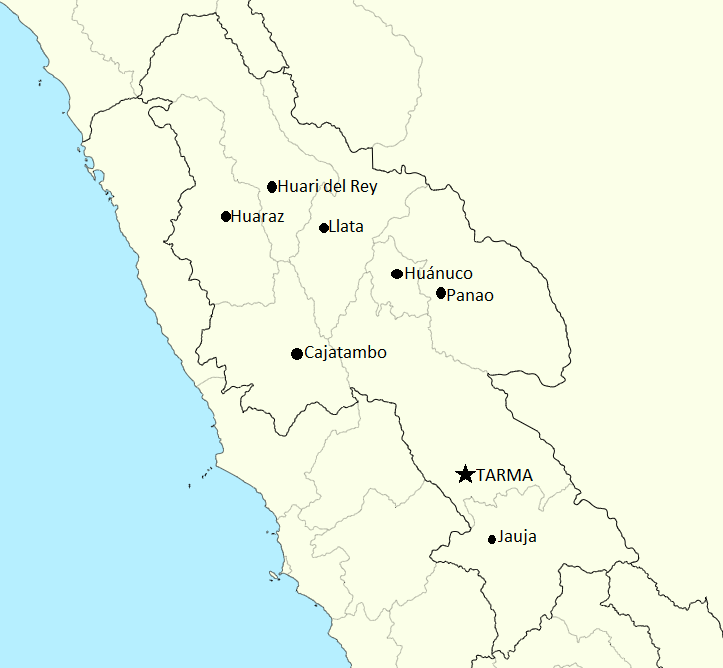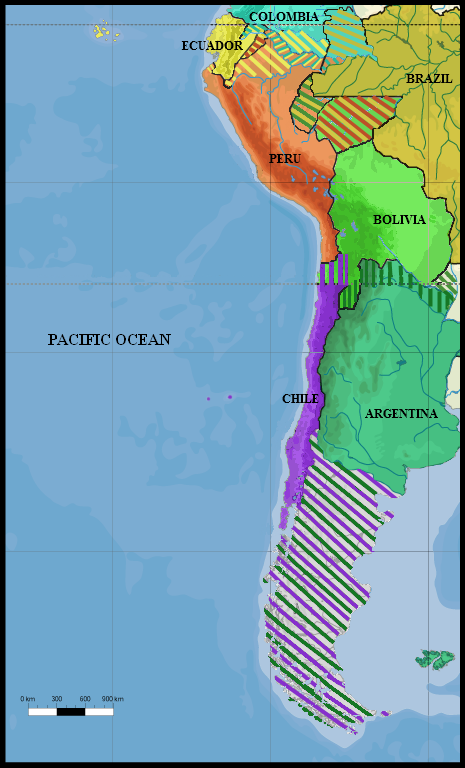|
Tarma
Santa Ana de la Ribera de Tarma, known as Tarma, is the capital city of Tarma Province in Junín Region, Peru. The city has a population of 43,042 as of the 2017 census. History Pre-Hispanic era Recent archaeological excavations show that prior to Inca occupation, the gorges of Tarma were settled by many ethnic groups. The Chinchaycocha were to the northwest, mainly what is today La Oroya and northern part of the valley. The xauxa settled to the southern part, south of Tarma river. A small group called Palcamayo settled to the east section. When the Inca arrived, they built up a new province in Tarma. They took away people and territory from the former ethnic groups and building a strategic political province, which allowed them to better control the large ethnic groups of Chinchaycocha, Xauxa and Wanka. Tarma became a sort of buffer zone for the Inca. The capital of the Inca province was Tarmatambo. Tarma was founded during the policy of "reducciones" under the rule of fifth ... [...More Info...] [...Related Items...] OR: [Wikipedia] [Google] [Baidu] |
Intendancy Of Tarma
The Intendancy of Tarma (), also known informally as Tarma Province (), was one of the territorial divisions of the Viceroyalty of Peru. The territory was ruled from Tarma. It existed from its creation in 1784 until it was Reglamento Provisional, replaced by the Regions of Peru, departments of Department of Tarma, Tarma and Department of Huaylas, Huaylas on February 12, 1821. History The corregimientos were suppressed in 1784 by King Charles III of Spain, Charles III and replaced by the Intendencia indiana, intendancies. The intendancy system was established in the Viceroyalty of Peru by royal order of August 5, 1783, and the Royal Ordinance of Intendants of January 28, 1782 was applied. In the territory of the Archdiocese of Lima, archbishopric of Lima, the intendancies of Intendancy of Lima, Lima and Tarma were created. The intendancy of Tarma was made up of the ''corregimientos'' of Tarma, Huaylas, Jauja, Cajatambo, Conchucos, Huamalíes and Huánuco. The first intendant of Tar ... [...More Info...] [...Related Items...] OR: [Wikipedia] [Google] [Baidu] |
Tarma District
Tarma District is one of nine districts of the province Tarma in Peru Peru, officially the Republic of Peru, is a country in western South America. It is bordered in the north by Ecuador and Colombia, in the east by Brazil, in the southeast by Bolivia, in the south by Chile, and in the south and west by the Pac .... The archaeological site Tarmatampu is situated in the district. Geography Some of the highest mountains of the district are listed below:escale.minedu.gob.pe - UGEL map of the Tarma Province (Junín Region) Climate Images File:Tarmatambo.jpg, Tarmatampu References Districts of the Department of Junín Districts of the Tarma province {{Junín-geo-stub ... [...More Info...] [...Related Items...] OR: [Wikipedia] [Google] [Baidu] |
Regions Of Peru
According to the ''Organic Law of Regional Governments'', the regions () are, with the departments, the first-level semi autonomous administrative subdivisions of Peru. Since its Peruvian War of Independence, 1821 independence, Peru had been divided into departments of Peru, departments (Regions) Peru’s 24 departments each have a regional government and legislature responsible for administration, economic planning, and public services. These governments operate with autonomy while still coordinating with national authorities. Each department is led by a regional governor, who is elected by popular vote for a four-year term. The governor is responsible for implementing regional policies, managing budgets, and overseeing infrastructure projects. Supporting the governor is the regional legislative council, composed of elected representatives from different provinces within the department. This council approves budgets, monitors public investments, and ensures government accountab ... [...More Info...] [...Related Items...] OR: [Wikipedia] [Google] [Baidu] |
Provinces Of Peru
The provinces of Peru () are the second-level administrative subdivisions of the country. They are divided into districts (). There are 196 provinces in Peru, grouped into 25 regions, except for Lima Province which does not belong to any region. This makes an average of seven provinces per region. The region with the fewest provinces is Callao (one) and the region with the most is Ancash (twenty). While provinces in the sparsely populated Amazon rainforest of eastern Peru tend to be larger, there is a large concentration of them in the north-central area of the country. The province with the fewest districts is Purús Province, with just one district. The province with the most districts is Lima Province, with 43 districts. The most common number of districts per province is eight; a total of 29 provinces share this number of districts. Provinces table The table below shows all provinces with their capitals and the region in which they are located. The UBIGEO code unique ... [...More Info...] [...Related Items...] OR: [Wikipedia] [Google] [Baidu] |
José Gálvez Moreno
José Miguel Gálvez Moreno (Tarma, February 17, 1850 — Lima, April 29, 1894), was a Peruvian sailor and politician considered a war hero in Peru for his actions during the War of the Pacific. He was a son of José Gálvez Egúsquiza, who died in the Battle of Callao during the Chincha Islands War, also considered a war hero in Peru. Biography He was the son of José Gálvez Egúsquiza and Ángela Moreno y Maíz. After studying at the College of Our Lady of Guadalupe, he entered the Naval Academy and graduated as a midshipman in 1865. He served on the frigate and then on the ''Apurímac'' frigate, aboard which he fought in the battle of Abtao, being promoted to ''alférez de fragata'' in April 1866. After the combat on May 2, he attended the examination of the remains of his father, managing to identify them. Shortly thereafter he left the service and went on to study abroad. He rejoined in October 1870 and completed his studies at the Naval Academy. In June 1871 he we ... [...More Info...] [...Related Items...] OR: [Wikipedia] [Google] [Baidu] |
Peru
Peru, officially the Republic of Peru, is a country in western South America. It is bordered in the north by Ecuador and Colombia, in the east by Brazil, in the southeast by Bolivia, in the south by Chile, and in the south and west by the Pacific Ocean. Peru is a Megadiverse countries, megadiverse country, with habitats ranging from the arid plains of the Pacific coastal region in the west, to the peaks of the Andes mountains extending from the north to the southeast of the country, to the tropical Amazon basin rainforest in the east with the Amazon River. Peru has Demographics of Peru, a population of over 32 million, and its capital and largest city is Lima. At , Peru is the List of countries and dependencies by area, 19th largest country in the world, and the List of South American countries by area, third largest in South America. Pre-Columbian Peru, Peruvian territory was home to Andean civilizations, several cultures during the ancient and medieval periods, and has one o ... [...More Info...] [...Related Items...] OR: [Wikipedia] [Google] [Baidu] |
War Of The Pacific
The War of the Pacific (), also known by War of the Pacific#Etymology, multiple other names, was a war between Chile and a Treaty of Defensive Alliance (Bolivia–Peru), Bolivian–Peruvian alliance from 1879 to 1884. Fought over Atacama Desert border dispute, Chilean claims on Litoral Department, coastal Bolivian territory in the Atacama Desert, the war ended with victory for Chile, which gained a significant amount of resource-rich territory from Peru and Bolivia. The direct cause of the war was a nitrate taxation dispute between Bolivia and Chile, with Peru being drawn in due to its secret alliance with Bolivia. Some historians have pointed to deeper origins of the war, such as the interest of Chile and Peru in the nitrate business, a long-standing rivalry between Chile and Peru for regional hegemony, as well as the political and economical disparities between the stability of Chile and the volatility of Peru and Bolivia. In February 1878, Bolivia increased taxes on the Chile ... [...More Info...] [...Related Items...] OR: [Wikipedia] [Google] [Baidu] |
Districts Of Peru
The districts of Peru () are the third-level country subdivisions of Peru. They are subdivisions of the provinces of Peru, provinces, which in turn are subdivisions of the larger regions of Peru, regions or departments. There are 1,838 districts in total. Overview A 1982 law requires a minimum of residents in an area for a new district to be legally established: 3,500 if it is located in the rainforest, 4,000 in the Andes highlands and 10,000 in the Chala, coastal area. In the dry Andean area, many districts have less than 3,500 inhabitants due to low population density in the area. In some cases, their populations have decreased in comparison to the days when they were founded. Districts that are located at very high altitudes tend to be scarcely populated. These districts usually are large in area, have few available land for use. Many basic government services do not reach all residents of these districts due to their difficult geography. Many lack financial means to govern th ... [...More Info...] [...Related Items...] OR: [Wikipedia] [Google] [Baidu] |
Horticulture
Horticulture (from ) is the art and science of growing fruits, vegetables, flowers, trees, shrubs and ornamental plants. Horticulture is commonly associated with the more professional and technical aspects of plant cultivation on a smaller and more controlled scale than agronomy. There are various divisions of horticulture because plants are grown for a variety of purposes. These divisions include, but are not limited to: propagation, arboriculture, landscaping, floriculture and turf maintenance. For each of these, there are various professions, aspects, tools used and associated challenges -- each requiring highly specialized skills and knowledge on the part of the horticulturist. Typically, horticulture is characterized as the ornamental, small-scale and non-industrial cultivation of plants; horticulture is distinct from gardening by its emphasis on scientific methods, plant breeding, and technical cultivation practices, while gardening, even at a professional level, tends ... [...More Info...] [...Related Items...] OR: [Wikipedia] [Google] [Baidu] |
Floriculture
Floriculture (from ) is the study of the efficient production of the plants that produce showy, colorful flowers and foliage for human enjoyment in human environments. It is a commercially successful branch of horticulture and agriculture found throughout the world. Efficient production practices have been developed over the years, for the hundreds of plant taxa used in the floral industry, increasing the overall knowledge of whole plant biology. Plant breeding and selection have produced tens of thousands of new genotypes for human use. Overview Flowers are an important part of human society that are often used at times of joy and sadness, and as a part of everyday life. Flowers and plants may be indoors in a sunny window, as part of the landscape in the front yard or on the patio or deck in the back yard. People have been studying flowers and plants and their interaction with humans and how to produce these flowers and plants so all humans can enjoy them. Floriculture scie ... [...More Info...] [...Related Items...] OR: [Wikipedia] [Google] [Baidu] |





